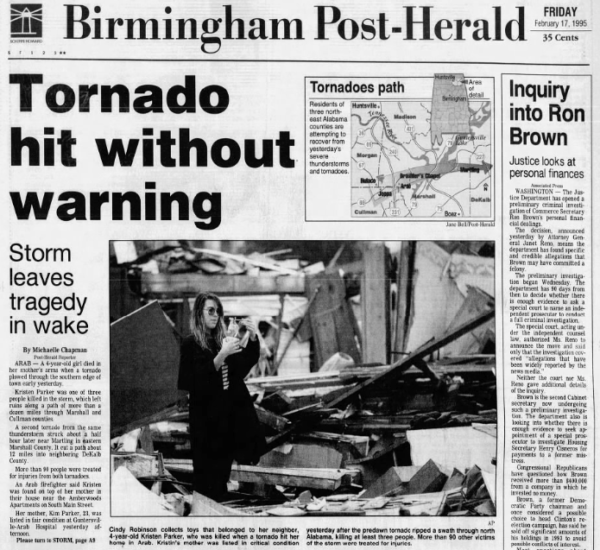The 1995 Arab Tornado
Just before dawn on Thursday morning, February 16, 1996, thunderstorms were sweeping across North and Central Alabama. The National Weather Service Forecast Office south of Birmingham had responsibility for counties across the central section of the state. The National Weather Service Office in Huntsville had responsibility for several counties in the Tennessee Valley. About 4:25 a.m., a lightning strike knocked out operations at the Huntsville weather office, including its radar. The Birmingham office assumed responsibility for issuing warnings for Huntsville’s counties. Forecasters would later say that the juggling of duties did play a role in the situation.
A severe thunderstorm warning was in effect for Cullman County at 4:55 a.m. for a severe storm over the northeastern part of the County. Meteorologists at the NWS Birmingham saw the signs of a developing tornado. But it was already almost into neighboring Marshall County, so the decision was made not to issue a tornado warning for Cullman County. A tornado warning was issued for Marshall County at 5:01 a.m. What weather service forecasters did not know was that a tornado did snake down from the thundercloud at 4:59 a.m. It fell with a fury on the tiny Cullman County community of Joppa. Newspaper reports said there was not much left of the town.
The city of Arab is just one mile from the border of Cullman and Marshall Counties and just four miles from the city of Arab. The tornado reached Arab at 5:06 a.m. Standard procedure was for dispatchers in the Arab Police Department to monitor a NOAA Weatheradio. When tornado warnings were issued, police officers would drive designated routes, sounding their sirens to warn residents. But no warning came. The Huntsville NOAA Weatheradio transmitter was knocked out by the lightning strike. There wouldn’t have been much time anyway. The warning was issued at 5:01 a.m. The tornado struck Arab four minutes later.
The F3 tornado chewed its way across the southern side of the city of Arab, reaching US-231 at 5:08 a.m. One person was killed in Cullman County. Five died in Marshall County. A total of 130 people were injured along the tornado’s 14 mile path.
Ironically, the Huntsville National Weather Service was scheduled to close as part of the modernization of the weather service. The National Weather Service in Birmingham was scheduled to take over responsibility for the counties in North Alabama. The Arab tornado fomented an uproar against closing the Huntsville office. Critics claimed that the missed warning gave credence to their charge that 54 counties were too many for the Birmingham office. On December 2, 1997, the Huntsville NWS Office closed. But under tremendous pressure from many people, led by Representative Bud Cramer, a new National Weather Service Office would open in Huntsville. It has responsibility for eleven North Alabama Counties and three counties in southern Tennessee. Cullman County emergency managers pushed to be a part of the Huntsville County Warning Area, and their wish was granted.
Category: ALL POSTS
















